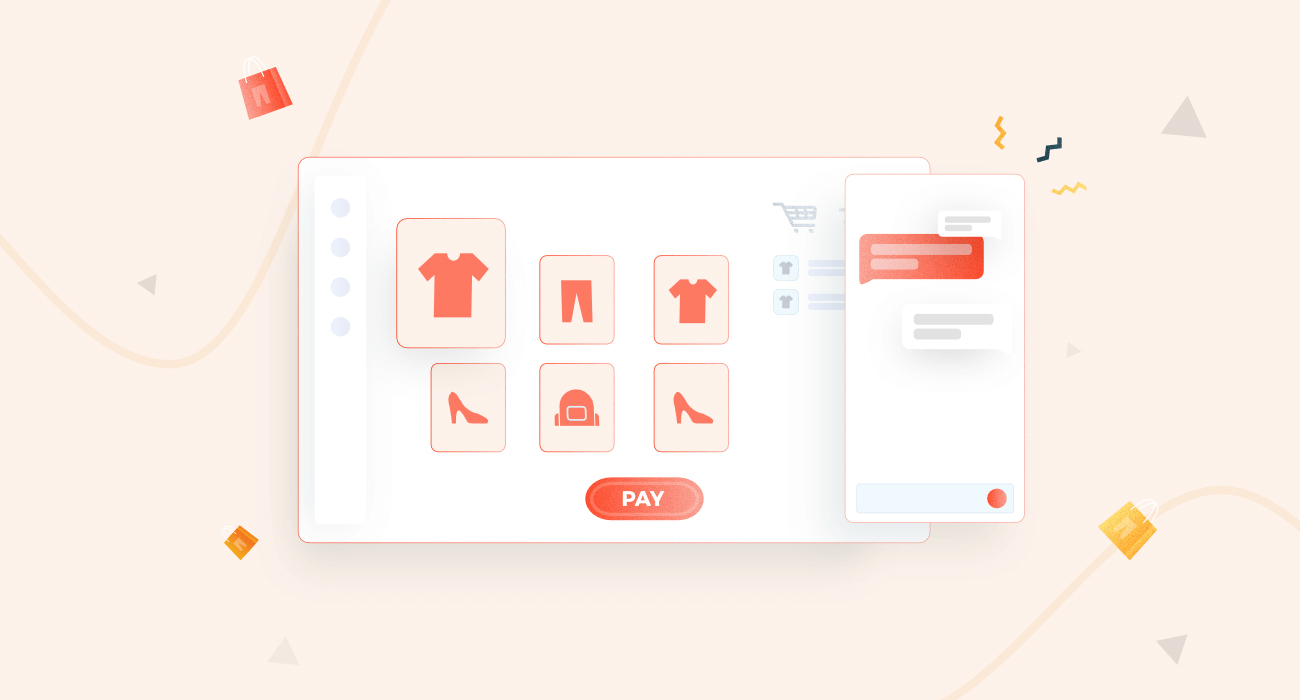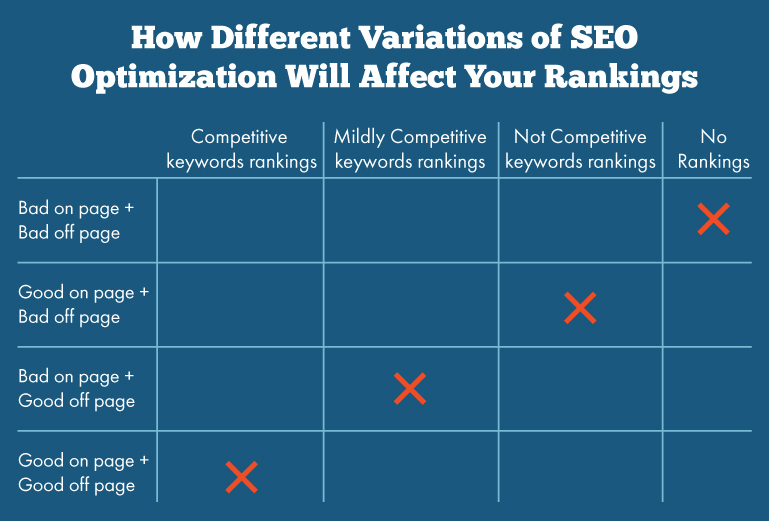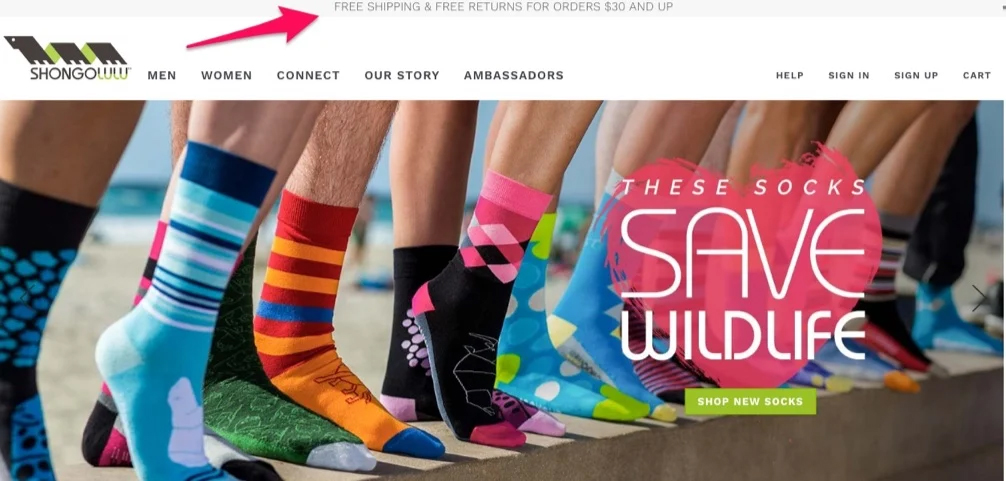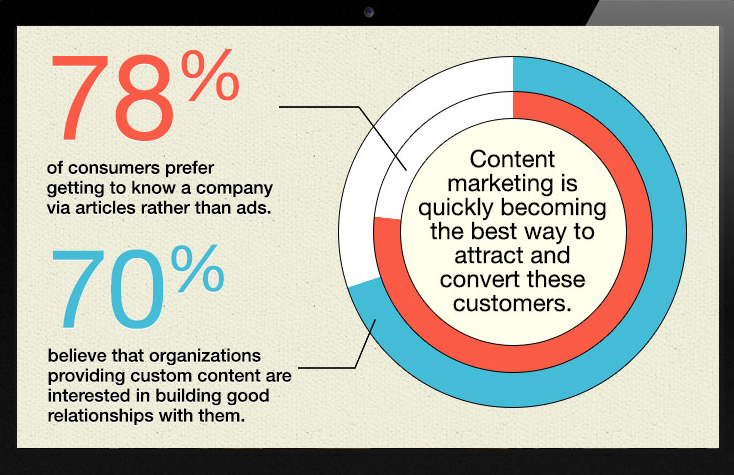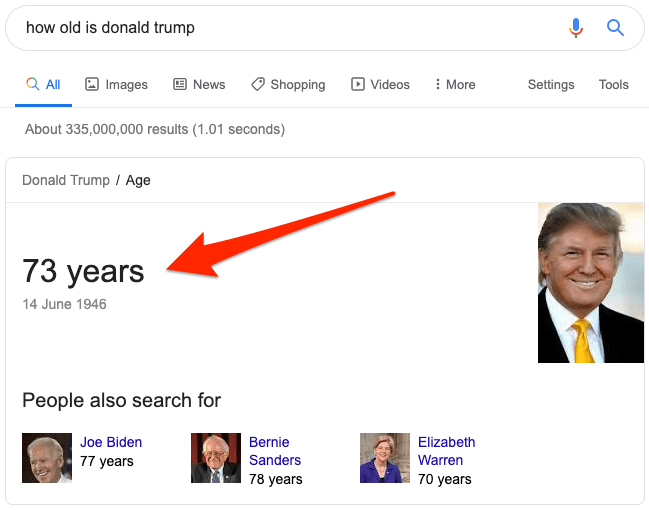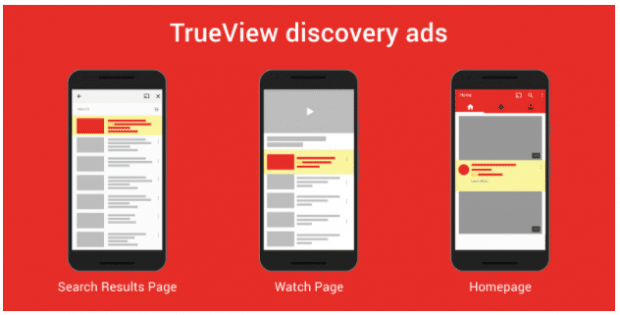There’s no better time than now to figure out how to promote your YouTube channel.
Why “now,” though?
For starters, YouTube recently overtook Facebook as the second most-visited site on the web.
In a day and age where we’re spending up to six hours per day consuming video, the writing is on the wall: we need to appeal to our customers’ binge-watching tendencies.
Of course, the boom of video content has resulted in a flood of brands trying to master YouTube channel marketing all at once.
And so if you want to stand out on YouTube, you need to take advantage of as many promotional tactics as possible.
Below we’ve broken down step-by-step how to promote your YouTube channel to maximize your viewership. Whether you’re just getting started or want to see your numbers tick upward, these tips are all fair game.
16 Proven tips to promote your YouTube Channel
1. Write engaging, must-see titles
YouTube marketing is all about presentation.
Like, literally.
Titles are make-or-break when it comes to your video’s performance. Ask yourself: are you presenting your content as “must-see” or “meh?”
The key to crafting killer titles is grabbing your audience’s attention without resorting to clickbait headlines. People crave content that’s entertaining, and they likewise want to know what your video is about from the word “go.”
For example, you can take a page out of the playbooks of YouTube giants like BuzzFeed and WhatCulture. Such videos often rely on listicles, question-based titles or hyperbole (“insane,” “…of all time”) to rack up the views.

Athlean X’s fitness-based videos are another good example. The channel’s content manages to sneak in relevant keywords in its titles while also coming across as conversational.

“Best-of” lists and “how-to” titles are always a safe bet, too. Here are some click-worthy titles from Disney Food Blog:

The takeaway here is that you should definitely spend time mulling over engaging titles rather than sticking with the first idea that pops into your head.
In terms of specifics, an oft-cited study from Tubular Insights notes that YouTube video titles should stick between 41 and 70 characters. Meanwhile, tools such as CoSchedule’s headline analyzer recommends 55 characters for an engaging headline. CoSchedule’s tool isn’t specifically meant for video titles but is awesome for brainstorming YouTube-friendly titles to help promote your YouTube channel.
Publish on YouTube with Sprout Social
The opportunities are virtually endless on YouTube, and you can now publish to YouTube directly from Sprout.
Host long-form video on your channel, extend reach through YouTube’s extensive search capabilities, and track how your performance stacks up to other social networks.
Start a free trial to give our YouTube publishing features a try.
2. Optimize your videos for visibility
Here’s some food for thought: YouTube videos show up in 70% of the top 100 Google search results.
Heck, see for yourself. Any given product or “how-to” query on Google will return something from YouTube.
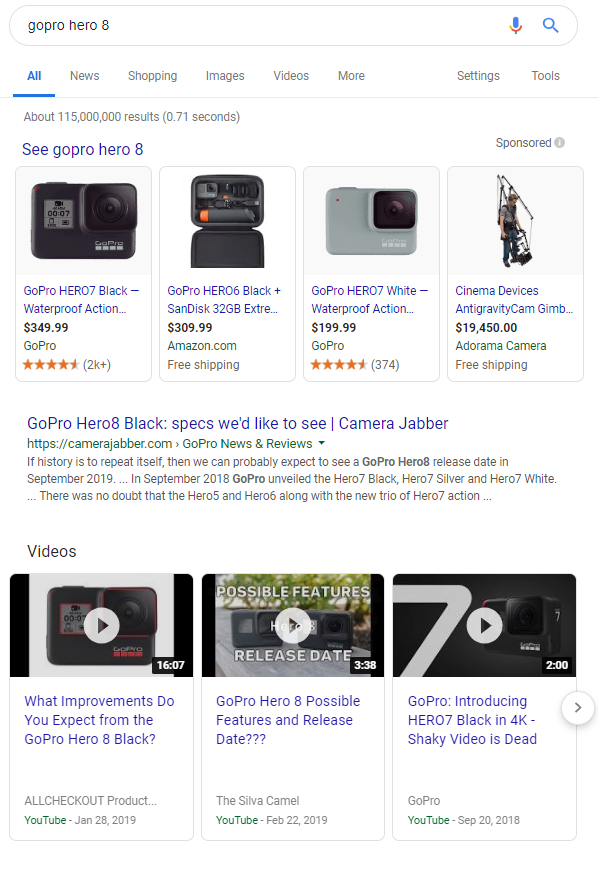
In fact, YouTube results sometimes even pop up before traditional blog posts or websites.
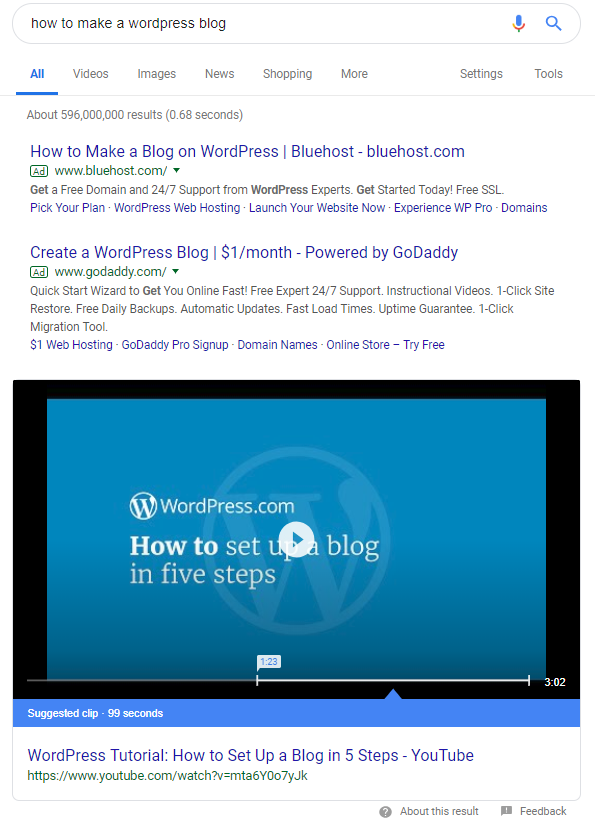
Listen: YouTube is the second-largest search engine in the world in and of itself. Just like people search for products and need problems solved via Google, the same rings true on YouTube.
Think of your YouTube videos like any other piece of content that needs to be optimized in terms of keywords, tags and so on.
In order to increase your chances of showing up, you’ll want to follow some of the best practices for YouTube SEO:
- Titles and description: Include target keywords in your titles and descriptions. You can use a tool like Keywordtool.io to help you find keyword ideas.
- Mention keywords in your video: According to Brian Dean of Backlinko, saying your target keywords in your video can help YouTube better understand what your video is about.
- Engagement: YouTube uses engagement (likes, comments, views) to help determine where videos rank in its search results.
- Categories: Use categories to help YouTube get a better understanding of who to show your videos to.
- Tags: In addition to categories, you can also add tags to your videos to give YouTube more context about your content. You can use quite a few tags, so add as many as you can think of.
Just like with SEO for your website, don’t keyword stuff. Use keywords when it makes sense, not just for the sake of having them.
3. Figure out what your audience wants
With any type of content you produce, you want to make sure it’s aligned with what your audience wants. Whether you’re writing a blog post or creating a video, start by getting to know your audience and what type of content they want to see from you.
If you’re just starting to promote your YouTube channel, take a look at your competitors or other video creators in your industry. Look at which of their videos get the most views and engagement. This will give you an idea of what topics your audience wants to learn about and what style of videos they prefer.
Another solution is to look at your YouTube Analytics if you’ve already uploaded videos. YouTube gives you detailed information on audience demographics, location, engagement and other helpful stats.
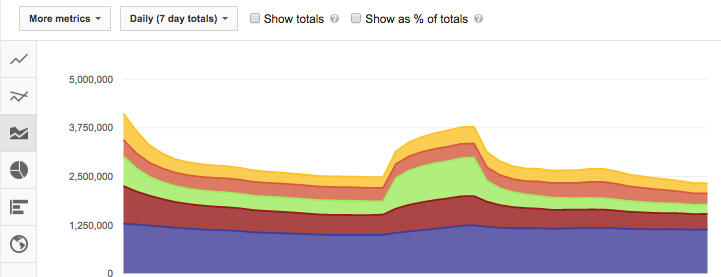
Want to better understand your YouTube metrics? Download our video metrics cheat sheet to learn the most important metrics to track and get ideas for video content tailored to your marketing goals.
Social Media Video Metrics & Ideas [Cheat Sheet]
4. Engage with the YouTube community
Although you might not think of YouTube as a social network per se, the platform does represent a thriving community where users are engaging via content via profiles, “likes” and comments.
Sounds pretty “social” if you ask us.
As noted earlier, any sort of interaction with your viewers is seen as a positive signal to YouTube. If nothing else, engaging with your subscribers can help you foster a stronger connection with your audience. “Liking” comments only takes a few seconds, as does pinning a top comment as a sort of personal note to your subscribers.
For example, music channel Artzie Musik regularly “likes” and responds to comments on its recent uploads. The channel’s creator regularly goes back-and-forth with subscribers to show appreciation and answer questions, too.
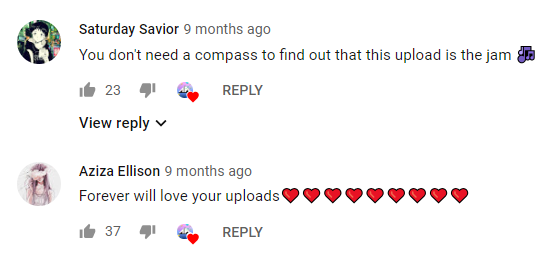
Just as you’d respond to comments and engage with your followers on any other social network, YouTube is no different.
5. Customize your thumbnails
One of the simplest yet effective tactics to promote your YouTube channel is creating custom thumbnails.
Think of your title and thumbnail as a sort of one-two punch to grab a viewer’s attention.
By default, YouTube snags a screenshot from any given video and uses it for the thumbnail. Unfortunately, sometimes the image it grabs will be a blurry shot of you adjusting the camera or a transition.
Not a good look, right?
Creating thumbnails yourself not only makes your videos look more appealing at a glance but also signals a certain sense of professionalism.
Thumbnails don’t have to be rocket science, either. You can even create a template with a particular font and style to make it more consistent and on-brand. This is made especially easy with the help of image creation tools such as Canva. Here’s a good example from Binging with Babish:
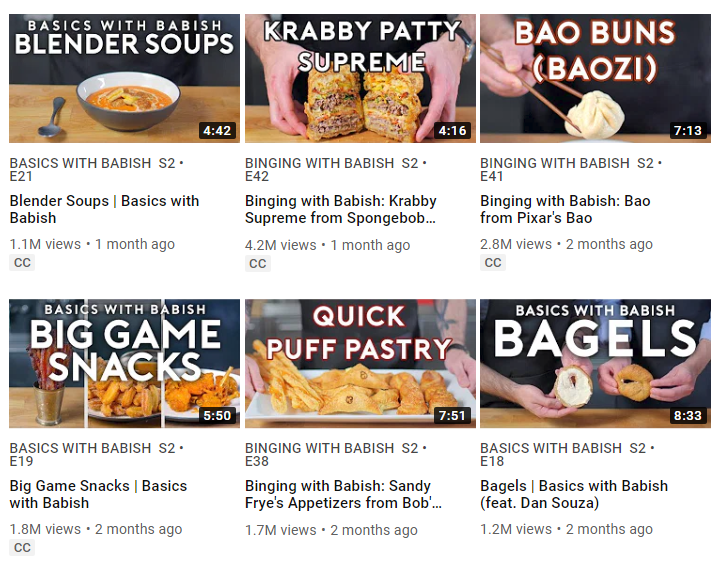
6. Cross-promote your videos on YouTube
Chances are you’re covering similar topics on YouTube that overlap with each other.
To squeeze more out of your older content, make a point to cross-promote your videos when it makes sense.
For example, you can drop links in the description of a video and encourage viewers to check them out as a sort of call-to-action. Although some might be disappointed by the recent removal of YouTube’s annotation system, linking in your description encourages viewers to watch your videos all the way through without clicking away.
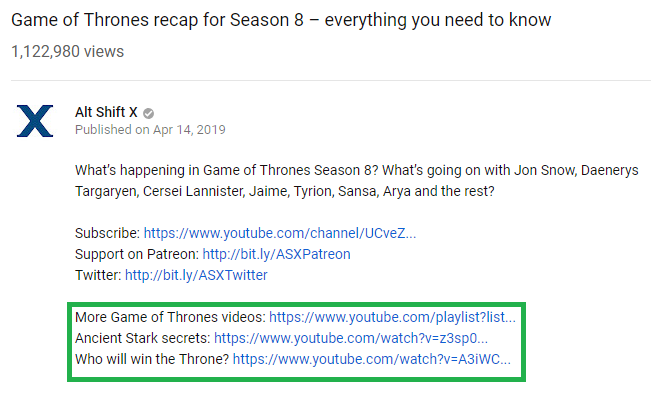
7. Target Google search results
As noted, YouTube is totally killing it when it comes to SEO.
And while you shouldn’t totally create content for search engines versus people, you should promote your YouTube channel with SEO in mind.
Specifically, product reviews, how-to’s and long-form (10+ minutes) videos covering keyword-specific topics tend to rank well in search engine results pages (SERPs). If you’re strapped for content ideas or want to capitalize on a trending buzzword in your industry, consider how you can do so through your YouTube channel marketing.
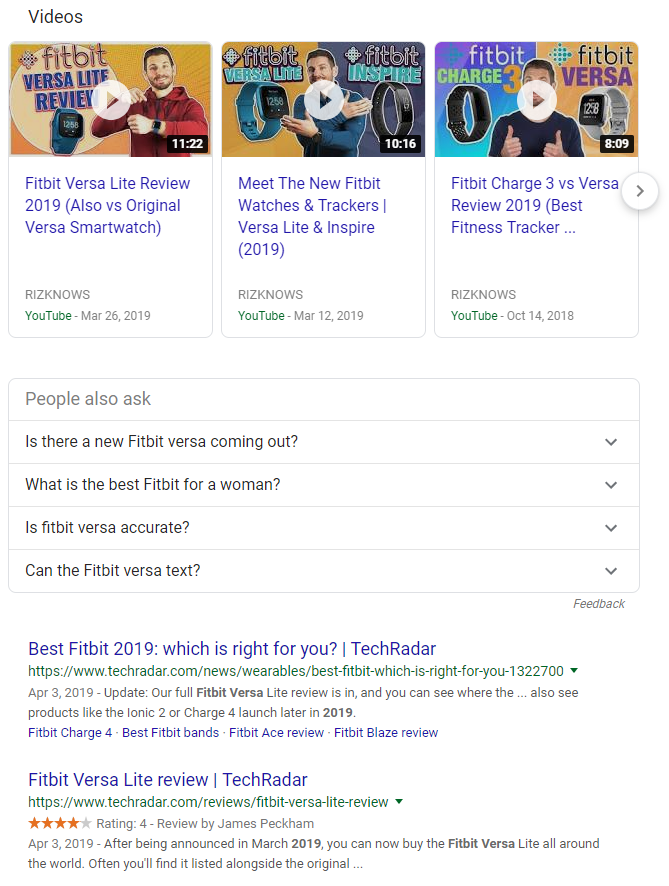
8. Run a contest or giveaway
If there’s one thing YouTube users love, it’s a giveaway. Host a YouTube contest or giveaway to encourage people to subscribe to your channel and engage.
To keep your contests simple, have people like your video, leave a comment and subscribe to your channel to enter.
Follow some of our best practices for running any social media contest:
- Make sure you’re following YouTube’s policies.
- Give away a gift that’s related to your brand: you want to attract more than just freebie-seekers.
- Get creative by incorporating user-generated content and other non-traditional entry requirements.
Be careful with hosting frequent YouTube contests, though. You want to make sure you’re getting results from your efforts: otherwise, you’ll end up wasting time, money and resources. After doing one contest, wait a while and look at your subscriber drop-off rate and engagement numbers. If you aren’t bringing in engaged subscribers, you could just be attracting people who want free prizes.
9. Encourage viewers to follow your series
A smart way to promote your YouTube channel is by creating a specific video series that covers a recurring theme or topic.
Popular foodie channel Bon Appétit actually has a variety of different series that make up their YouTube presence, including their ongoing “From the Test Kitchen” videos.
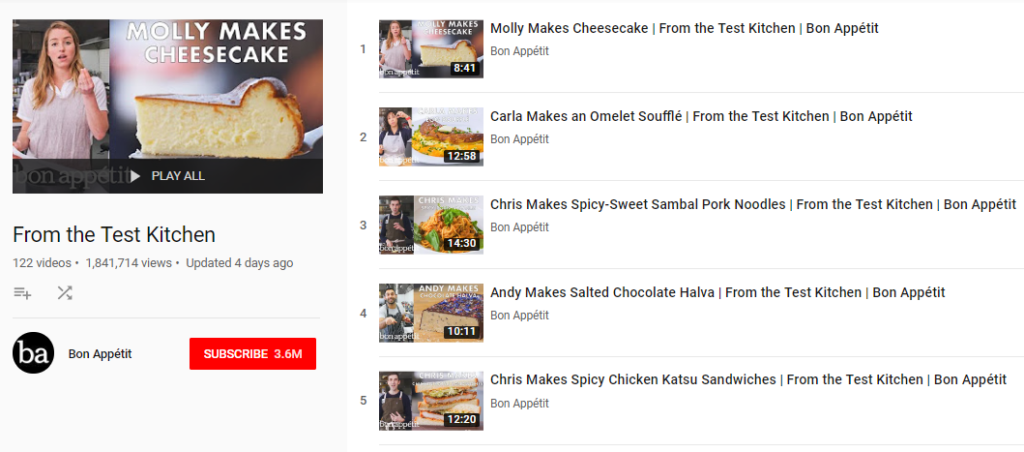
Series are a win-win for creators and viewers alike. For creators, you hold yourself accountable for creating fresh YouTube content and don’t have to rack your brain for ideas. For your audience, they have something to look forward to and likewise a reason to keep returning to your channel.
10. Embed your YouTube videos
Some of the best places to promote your YouTube channel are beyond YouTube itself.
Case in point, video content is proven to improve conversion rates and lower bounce rate on-site. If you want visitors to stick around a product page or blog post longer, embed a video (like we did below).
Remember: any opportunity you have to funnel your on site (or social!) traffic to YouTube is a plus.
11. Create playlists to organize your YouTube content
The more videos you create, the more difficult it becomes for people to navigate through your channel.
That’s why playlists are so important. Not only do playlists allow you to group your videos into categories to organize your channel, but also appeal to your viewers’ desire to binge.
For example, Beardbrand’s grooming channel uploads daily and therefore has amassed hundreds of videos covering tons of topics. The channel’s various playlists help guide subscribers to relevant content without having to dig for it.
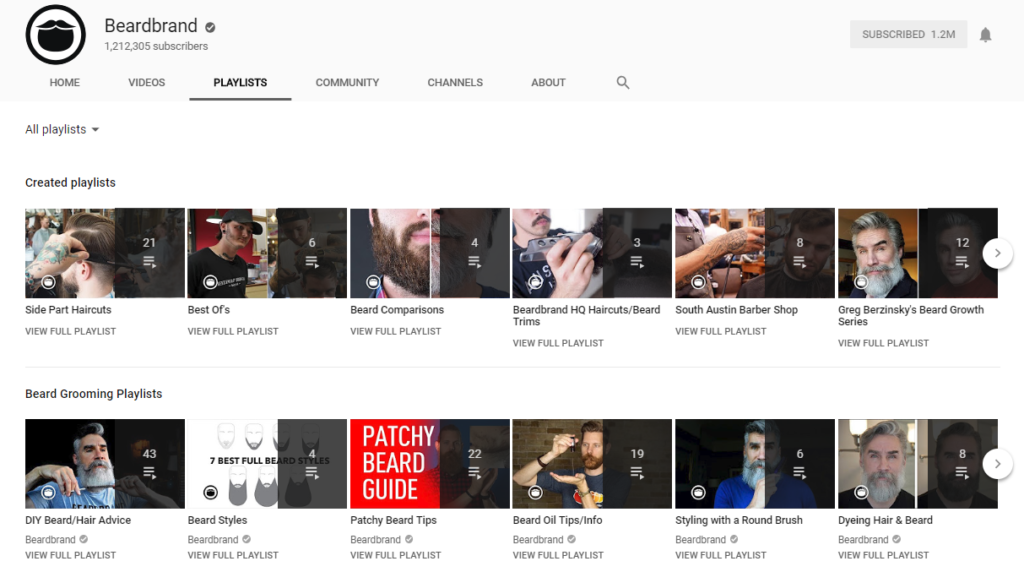
12. Increase engagement with calls to action
Sometimes simply asking for engagement is the best way to get your videos noticed, especially when you consider the immediacy and connection that video content can create.
Not everyone who enjoys one of your videos is going to remember drop a like or become your subscriber, so it’s become increasingly common to put these reminders in the description or in the video itself.
Especially if you’re an up-and-coming channel, there’s no shame in asking for some love directly. In fact, asking visitors a question to answer in the comments suggestion or to check out another video are perfect ways to keep the engagement rolling. You can likewise link to other videos or drop an external link to your site to serve as a sort of CTA.
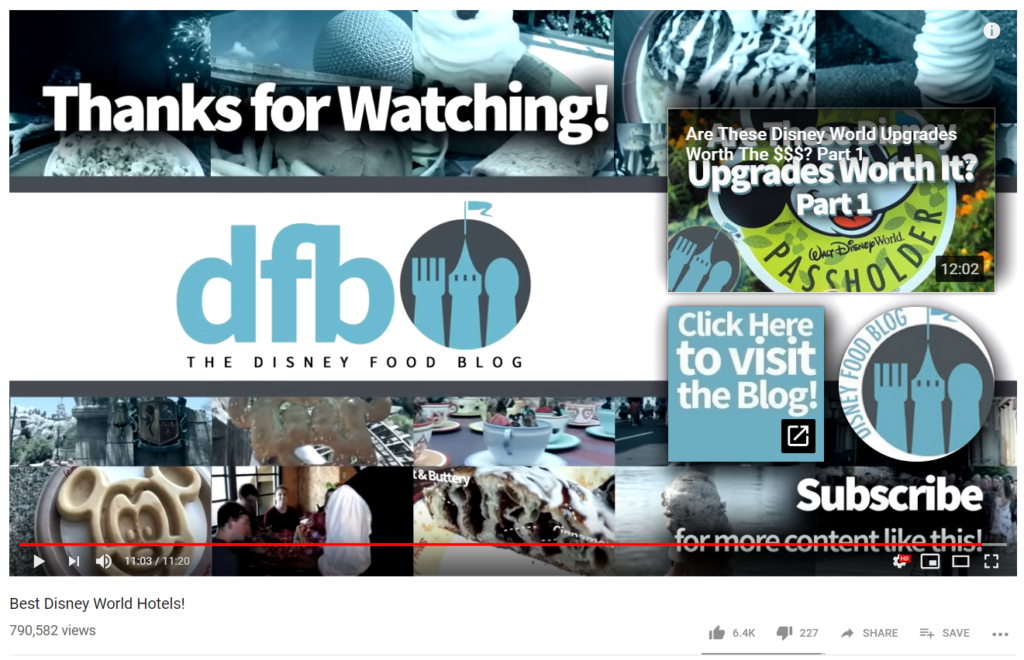
13. Give live streaming a try
Live video is one of the biggest social media trends and it isn’t going anywhere anytime soon.
With apps like Facebook, Periscope and Instagram making it easier than ever to stream live video, more and more brands are getting on board.
YouTube has been offering live videos for years but has only recently started picking up steam. You can take a look at some popular YouTube Live videos to get a sense of how other brands are using the platform.

Some examples of how you can use YouTube Live are:
- Webinars
- Live tutorials
- Q&A sessions
- Product demonstrations
Don’t worry if your streams don’t go as smoothly as you’d like. Part of the fun (and risk) of live video is you never know what’s going to happen. The unpolished, organic nature of live video is exactly what makes it compelling. For more tips on how to get started with YouTube Live, check out Google’s introduction to live streaming.
14. Collaborate with other creators and brands
A tactic some of the biggest YouTube stars used to grow their following is collaborating with other users. Each collaboration gives you exposure to a new audience. And the best part is those new viewers are more likely to subscribe to your channel since you’re working with a content creator they already know, like and trust.
The key to a successful YouTube collaboration is finding the right partner. You want to collaborate with content creators that share similar passions with your brand so your video comes off as authentic. This now-classic collaboration between BuzzFeed and Purina is a prime example of a thoughtful collaboration that doesn’t feel overly promotional.
15. Run a paid YouTube ad campaign
With marketing in general becoming more pay-to-play, you always have the option to get more visibility through paid YouTube ads. YouTube offers a variety of ad formats to choose from:
- Display ads: These ads show up on the right-hand sidebar of videos, and are only available on desktop.
- Overlay ads: These are semi-transparent ads that are displayed on the bottom part of a video. They’re only available on desktop.
- Skippable and non-skippable video ads: These ads show up before, during or after a video. Skippable ads can be skipped after five seconds, but non-skippable ads have to be watched all the way through before the viewer can watch their video.
- Bumper ads: These are non-skippable ads that have to be watched before the viewer can watch their video. They can be a maximum of six seconds.
- Sponsored cards: These are cards that get displayed within relevant videos. You can use them to promote your products or other content.
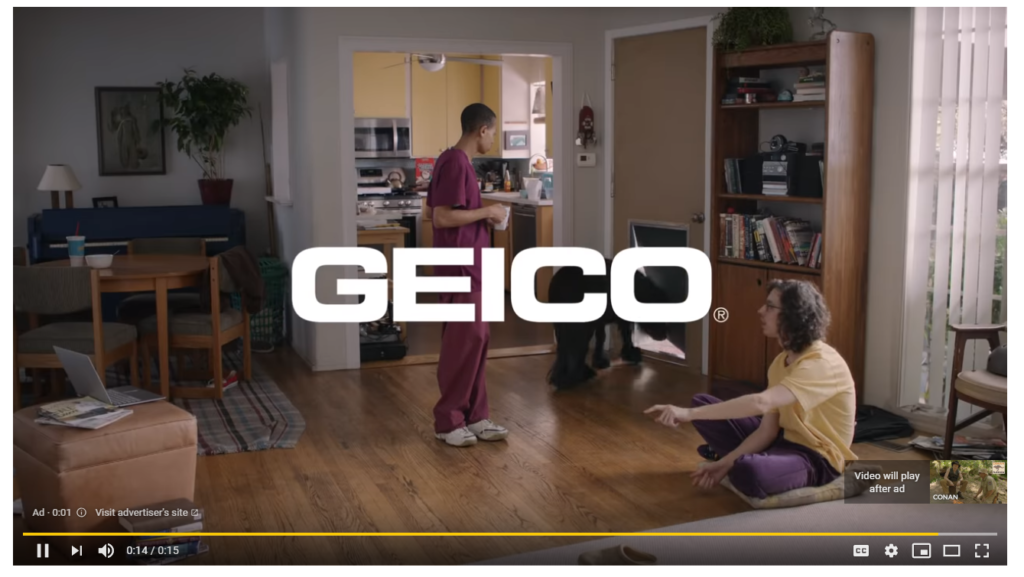
For your ad creatives, you can either use an existing video or create something new for a specific campaign. The advantage of using an existing video is you can choose a clip you know has been effective in the past. If a video has already gotten a lot of views and engagement organically, running paid ads can amplify your results.
On the flip side, creating a new video for your ads will allow you to create a more targeted piece of content that you have more control over. For instance, you can create an ad with a specific call-to-action at the end to direct viewers to a landing page or another video. You can learn more about YouTube’s video ad formats here.
16. Regularly publish your YouTube content to social media
It’s no secret that video content crushes it on social media in terms of engagement and performance.
As a result, you should regularly promote your YouTube channel to your social followers to encourage them to become subscribers. As soon as a video goes live, make a point to let your followers on Facebook, Twitter, Instagram and LinkedIn know about it. You can likewise create snippets or previews for each social platform that also link to your latest production.
With the help of Sprout Social, you can schedule your content and cross-promote it without having to jump from platform to platform. Features such as ViralPost can also help ensure that your content goes live based on when your social audiences are engaged.
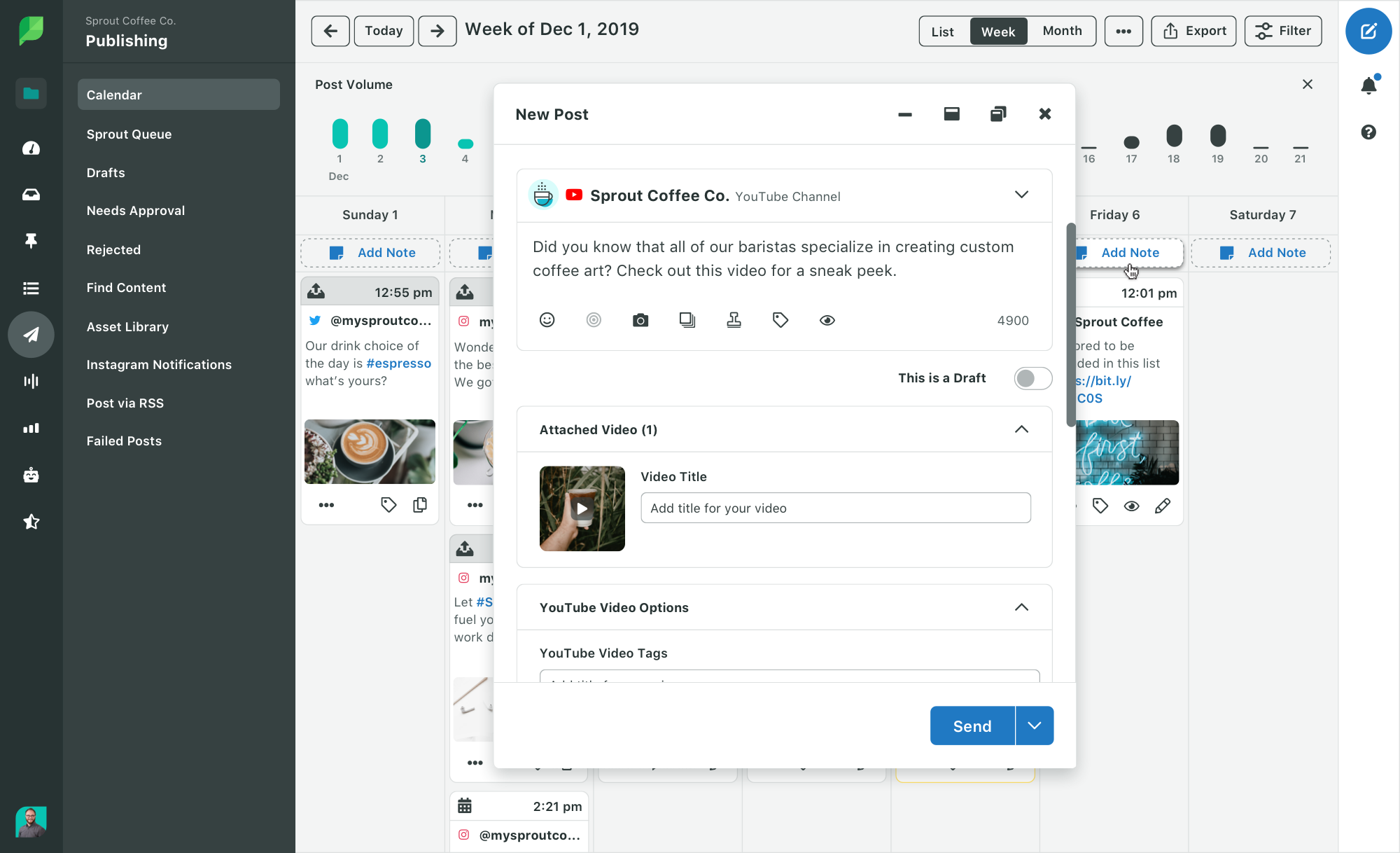
And with that, we wrap up our guide to YouTube channel marketing!
How do you promote your YouTube channel?
Growing a YouTube audience doesn’t happen by accident.
And yes, it can certainly feel like a grind if your space is crowded with competition.
That’s exactly why it pays to have a variety of promotional tactics in your back pocket. Although some of the tips above require more effort than others, each one can help you get more eyes on your channel and more subscribers as a result.
If you’re ready to ramp up your YouTube presence and start seeing real business results, download our social media video cheat sheet to get ideas for video at every stage of the marketing funnel.
Source: https://sproutsocial.com/insights/how-to-promote-your-youtube-channel/


